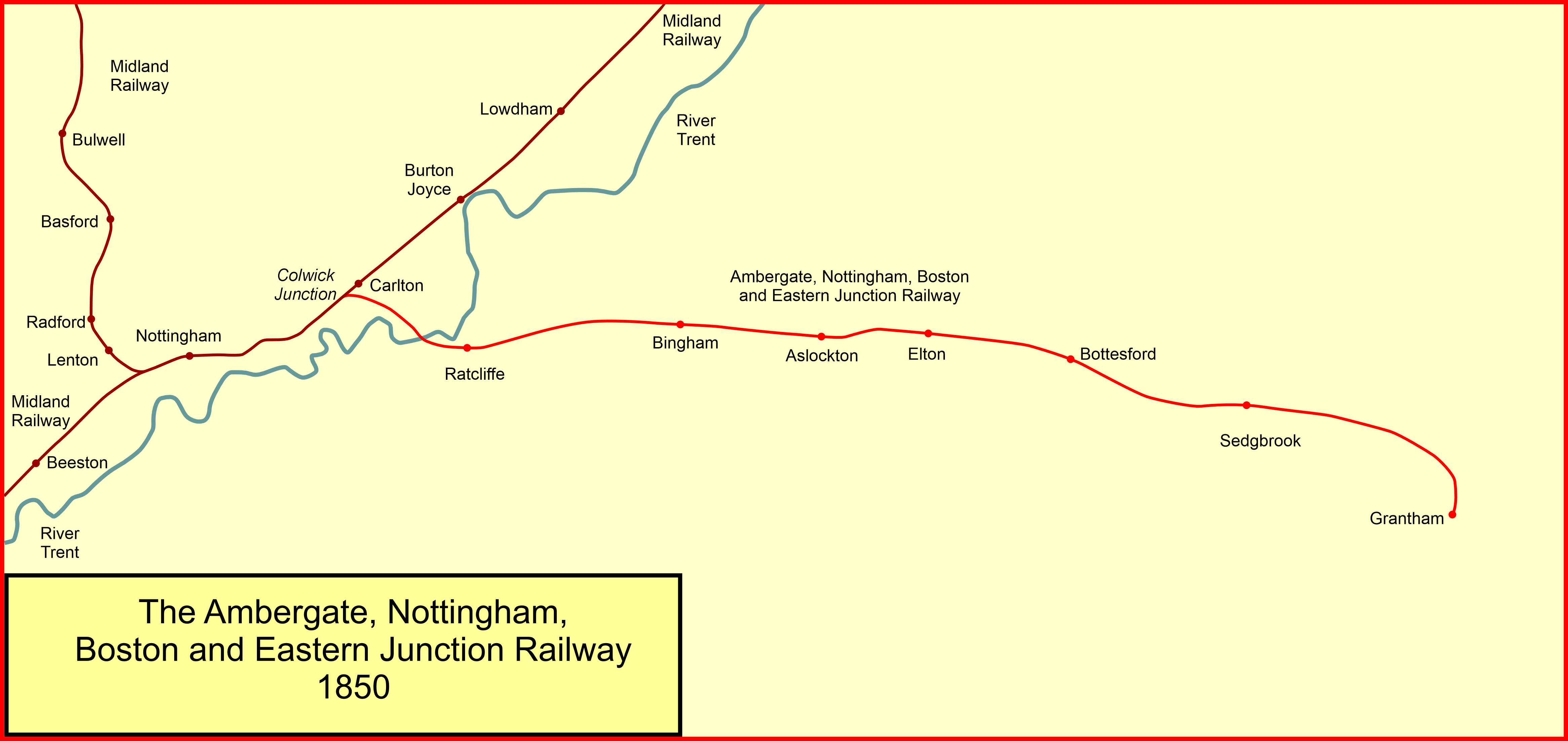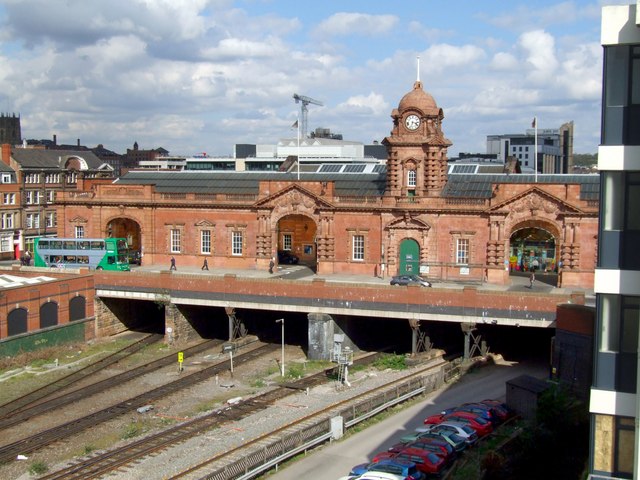|
Sedgebrook Railway Station
Sedgebrook railway station was on the Nottingham to Grantham line in the East Midlands of England. The station lay between Bottesford and Grantham. It served a population of about 900 in the villages of Sedgebrook and Allington and the hamlet of Casthorpe, all in Lincolnshire. It was closed in 1956. The line The line opened as the Ambergate, Nottingham, Boston and Eastern Junction Railway on 15 July 1850. It was then leased to the Great Northern Railway in 1855, but remained nominally independent until it was taken over by the London and North Eastern Railway The London and North Eastern Railway (LNER) was the second largest (after LMS) of the " Big Four" railway companies created by the Railways Act 1921 in Britain. It operated from 1 January 1923 until nationalisation on 1 January 1948. At th ... in 1923. References {{Closed stations Lincolnshire Disused railway stations in Lincolnshire Railway stations in Great Britain opened in 1850 Railway stat ... [...More Info...] [...Related Items...] OR: [Wikipedia] [Google] [Baidu] |
Sedgebrook
Sedgebrook is an English village and civil parish in the South Kesteven district of Lincolnshire. It lies on the A52 road, west of Grantham. Its population, given as 372 in 2001, fell by the 2011 census to 355, and was estimated to be 347 in 2019. Heritage Sedgebrook is mentioned in the 1086 ''Domesday Book'' as Sechebroc in the wapentake of Winnibriggs. The name Robert Malet and three mills are noted. Sechebroc means "Brook where sedge grows", from OE secg "sedge" and brôc "a brook" The parish church of St Lawrence is a largely 15th-century building with an early 13th-century north arcade and a 14th-century chancel arch. A pamphlet history of the church appeared in 1980 and was republished in 1990. The church is the only Grade I listed building in the village. Sedgebrook Manor House is Grade II* listed, and three other houses and three architectural features are Grade II. The church shares a priest with Foston, West Allington and Long Bennington. The Grantham Canal passes ... [...More Info...] [...Related Items...] OR: [Wikipedia] [Google] [Baidu] |
Allington, Lincolnshire
Allington is a village and civil parish in the South Kesteven district of Lincolnshire, England, north-west of Grantham. The 2001 census gave a parish population of 728 in 329 households. The population increased to 897 in 422 households in the 2011 census. History Some evidence has been found of settlement in the Neolithic period. Roman artefacts have also been found nearby. The population at the time of the ''Domesday Book'' was about 300.Allington: "History" allingtononline.co.uk. Retrieved 2 February 2018. At the time of the the name of the village was Adelinctune. It belonged to the historical |
Railway Stations In Great Britain Closed In 1956
Rail transport (also known as train transport) is a means of transport that transfers passengers and goods on wheeled vehicles running on rails, which are incorporated in tracks. In contrast to road transport, where the vehicles run on a prepared flat surface, rail vehicles (rolling stock) are directionally guided by the tracks on which they run. Tracks usually consist of steel rails, installed on sleepers (ties) set in ballast, on which the rolling stock, usually fitted with metal wheels, moves. Other variations are also possible, such as "slab track", in which the rails are fastened to a concrete foundation resting on a prepared subsurface. Rolling stock in a rail transport system generally encounters lower frictional resistance than rubber-tyred road vehicles, so passenger and freight cars (carriages and wagons) can be coupled into longer trains. The operation is carried out by a railway company, providing transport between train stations or freight customer facili ... [...More Info...] [...Related Items...] OR: [Wikipedia] [Google] [Baidu] |
Railway Stations In Great Britain Opened In 1850
Rail transport (also known as train transport) is a means of transport that transfers passengers and goods on wheeled vehicles running on rails, which are incorporated in tracks. In contrast to road transport, where the vehicles run on a prepared flat surface, rail vehicles (rolling stock) are directionally guided by the tracks on which they run. Tracks usually consist of steel rails, installed on sleepers (ties) set in ballast, on which the rolling stock, usually fitted with metal wheels, moves. Other variations are also possible, such as "slab track", in which the rails are fastened to a concrete foundation resting on a prepared subsurface. Rolling stock in a rail transport system generally encounters lower frictional resistance than rubber-tyred road vehicles, so passenger and freight cars (carriages and wagons) can be coupled into longer trains. The operation is carried out by a railway company, providing transport between train stations or freight customer facili ... [...More Info...] [...Related Items...] OR: [Wikipedia] [Google] [Baidu] |
Bottesford Railway Station
Bottesford railway station serves the village of Bottesford in Leicestershire, England. The station is 15 miles (24 km) east of Nottingham, on the lines to Grantham and Skegness. It is the least used station in Leicestershire. History The line through Bottesford was first opened by the Ambergate, Nottingham, Boston and Eastern Junction Railway on 15 July 1850, then taken over by the Great Northern Railway. The station buildings were designed by Thomas Chambers Hine. There was also a link to the old GNR Newark to Leicester cross-country route a short distance to the east; this remained in use for freight until 1988 but has since been lifted. From 7 January 1963 passenger steam trains between Grantham, Bottesford, Elton and Orston, Aslockton, Bingham, Radcliffe-on-Trent, Netherfield and Colwick, Nottingham London-road (High Level) and Nottingham (Victoria) were replaced by diesel multiple-unit trains. The station is now owned by Network Rail and managed by East Midlands ... [...More Info...] [...Related Items...] OR: [Wikipedia] [Google] [Baidu] |
Ambergate, Nottingham, Boston And Eastern Junction Railway
The Ambergate, Nottingham and Boston and Eastern Junction Railway was a British railway company, which hoped to connect Lancashire with the port of Boston, in Lincolnshire. It was authorised in 1846 but was unable to raise much money. It opened a standard gauge line from a junction near Nottingham to Grantham in 1853. At Nottingham it was to rely on the Midland Railway, but that company was hostile and obstructive. The Ambergate company was leased to the Great Northern Railway in 1855, and they built their own Nottingham station, opened in 1857. In 1860 the company changed its name to the Nottingham and Grantham Railway and Canal Company. In 1875 the Great Northern Railway opened a line into Derbyshire and the former Nottingham to Grantham line became an important trunk route, particularly for goods and mineral traffic. The original line from Colwick to Grantham is still in use as the Nottingham–Grantham line. The freight traffic has greatly diminished, but the line is used f ... [...More Info...] [...Related Items...] OR: [Wikipedia] [Google] [Baidu] |
Casthorpe
Casthorpe is hamlet in the civil parish of Barrowby and the South Kesteven District of Lincolnshire, England. It is south-southwest from the city and county town of Lincoln, west from Grantham town centre, and west from Barrowby village. History There are two medieval sites at Casthorpe, defining the two former settlements of East and West Casthorpe, both recorded in 14th-century subsidy rolls. East Casthorpe (), with no evidence apart from earlier maps, was sited at or around Casthorpe Lodge. West Casthorpe (), was sited at Casthorpe House Farm, evidenced by aerial photographs faintly showing earthworks, enclosures, ridges and furrows, cropmarks, a possible moat, and possible crofts. Both settlements are mentioned in the ''Domesday Book'', listed as "Caschingetorp", "Chaschingetorp", "Chaschintorp" and "Kaschingetorp" as four probable manors covering the Casthorpe settlement. ''Kelly's Directory'' listed, as the only trades in Casthorpe, three farmers in 1855, two farmers ... [...More Info...] [...Related Items...] OR: [Wikipedia] [Google] [Baidu] |
Bottesford Railway Station
Bottesford railway station serves the village of Bottesford in Leicestershire, England. The station is 15 miles (24 km) east of Nottingham, on the lines to Grantham and Skegness. It is the least used station in Leicestershire. History The line through Bottesford was first opened by the Ambergate, Nottingham, Boston and Eastern Junction Railway on 15 July 1850, then taken over by the Great Northern Railway. The station buildings were designed by Thomas Chambers Hine. There was also a link to the old GNR Newark to Leicester cross-country route a short distance to the east; this remained in use for freight until 1988 but has since been lifted. From 7 January 1963 passenger steam trains between Grantham, Bottesford, Elton and Orston, Aslockton, Bingham, Radcliffe-on-Trent, Netherfield and Colwick, Nottingham London-road (High Level) and Nottingham (Victoria) were replaced by diesel multiple-unit trains. The station is now owned by Network Rail and managed by East Midlands Rail ... [...More Info...] [...Related Items...] OR: [Wikipedia] [Google] [Baidu] |
Lincolnshire
Lincolnshire (abbreviated Lincs.) is a county in the East Midlands of England, with a long coastline on the North Sea to the east. It borders Norfolk to the south-east, Cambridgeshire to the south, Rutland to the south-west, Leicestershire and Nottinghamshire to the west, South Yorkshire to the north-west, and the East Riding of Yorkshire to the north. It also borders Northamptonshire in the south for just , England's shortest county boundary. The county town is Lincoln, where the county council is also based. The ceremonial county of Lincolnshire consists of the non-metropolitan county of Lincolnshire and the area covered by the unitary authorities of North Lincolnshire and North East Lincolnshire. Part of the ceremonial county is in the Yorkshire and the Humber region of England, and most is in the East Midlands region. The county is the second-largest of the English ceremonial counties and one that is predominantly agricultural in land use. The county is fourth-larg ... [...More Info...] [...Related Items...] OR: [Wikipedia] [Google] [Baidu] |
Grantham Railway Station
Grantham railway station is on the East Coast Main Line in the United Kingdom, serving the town of Grantham, Lincolnshire. It is down the line from and is situated on the main line between to the south and to the north. Two secondary lines diverge from the main line north of Grantham: the "Poacher Line" to and a branch line to . Its three-letter station code is GRA. History The original station at Grantham ( Old Wharf) was opened when the Ambergate, Nottingham, Boston & Eastern Junction Railway opened its line from Nottingham on 15 July 1850. This line was taken over by the Great Northern Railway in 1854. This was replaced by the present station which opened on 1 August 1852; the Old Wharf station closed the following day. The new station was on the GNR's direct line between Peterborough and Retford (the Towns Line), which was completed in 1852. The alternative route via Boston and Lincoln (the Fens Loop Line) had already opened in 1850. The Boston, Sleaford and Mid ... [...More Info...] [...Related Items...] OR: [Wikipedia] [Google] [Baidu] |
Nottingham Railway Station
Nottingham station, briefly known as Nottingham City and for rather longer as Nottingham Midland, is a railway station and tram stop in the city of Nottingham. It is the principal railway station of Nottingham. It is also a nodal point on the city's tram system, with a tram stop that was originally called Station Street but is now known as Nottingham Station. The station was first built by the Midland Railway (MR) in 1848 and rebuilt by the same company in 1904, with much of the current building dating from the later date. It is now owned by Network Rail and managed by East Midlands Railway (EMR). Besides EMR trains, it is also served by CrossCountry and Northern trains and by Nottingham Express Transit (NET) trams. The station was one of several that once served the city of Nottingham. Amongst these were the city centre stations of on the Great Central Railway, and on the Great Northern Railway; both of these stations are now closed. A number of minor stations served l ... [...More Info...] [...Related Items...] OR: [Wikipedia] [Google] [Baidu] |




